If you’re looking for a colorful and lively addition to your aquarium, the Jack Dempsey cichlid might be just what you need. I’ve been keeping fish for years, and the Jack Dempsey has always been one of my favorites. With their striking colors and playful personalities, these fish are sure to be a hit with any fish enthusiast.
But before you dive in and add a Jack Dempsey to your tank, there are a few things you should know about their care. These fish can be a bit more challenging to care for than some other species, but with the right setup and attention, they can thrive in your aquarium.
The Jack Dempsey is a popular aquarium fish due to its unique appearance and hardy nature. They require a tank of at least 55 gallons with a temperature range of 72-82°F, pH range of 6.5-8.0, and a varied diet of commercial flakes, pellets, and live or frozen foods. They are generally aggressive and territorial towards other fish, especially during breeding season.
In this article, I’ll cover everything you need to know about Jack Dempsey cichlid care. From their natural habitat to their dietary needs, I’ll provide you with all the information you need to keep your fish healthy and happy. So, let’s get started!
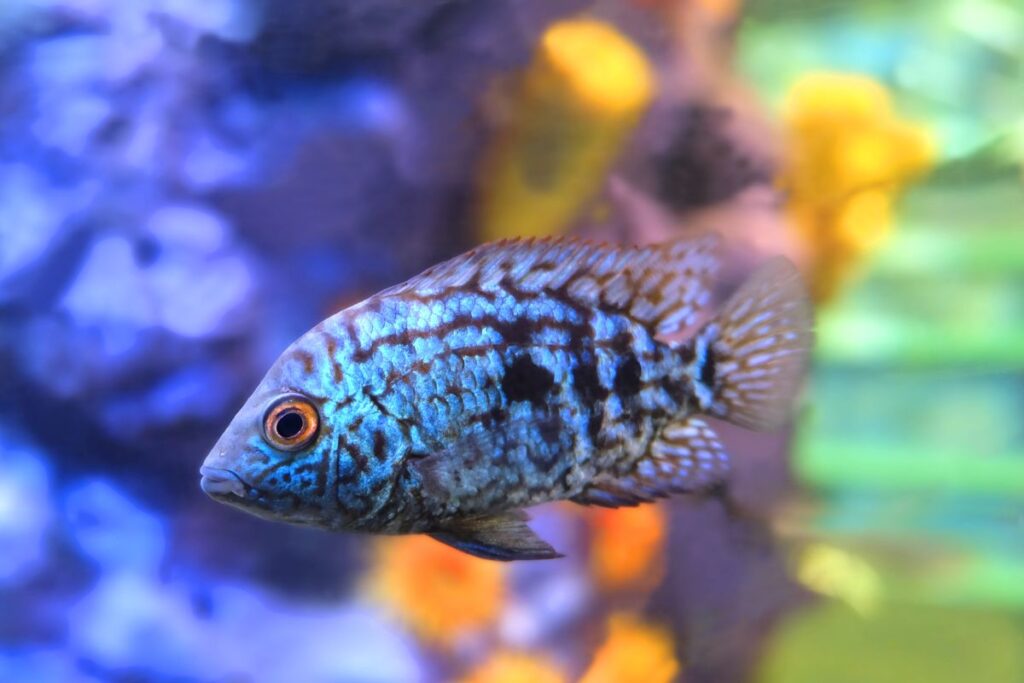
Table of Contents
Species Summary
Origin
I’ve always been fascinated by the Jack Dempsey cichlid. These fish are native to Central America, specifically Mexico, Honduras, and Guatemala.
They can be found in slow-moving rivers and streams, as well as in lakes and ponds.
Lifespan
Jack Dempsey cichlids have a relatively long lifespan for a freshwater fish. With proper care, they can live up to 10-15 years.
However, it’s important to note that their lifespan can be significantly shorter if they are not given the proper care.
Appearance
These fish have a unique and striking appearance that makes them a popular choice for aquarium enthusiasts.
They have a dark brown or black base color with blue-green and gold iridescent spots on their body and fins.
They also have a distinctive black spot on their gill cover, which is said to resemble a boxer’s eye.
Size
Jack Dempsey cichlids can grow up to 10-15 inches in length, making them a relatively large freshwater fish.
They can also be quite bulky and muscular, which adds to their impressive appearance.
Growth Rate
These fish have a moderate growth rate and can take up to 2-3 years to reach their full size.
However, their growth rate can be affected by factors such as water quality, diet, and tank size.
Behavior & Temperament
Jack Dempsey cichlids are known for their aggressive behavior, especially towards other fish.
It’s important to keep them in a species-only tank or with other large, aggressive fish that can hold their own.
They are also known for their digging behavior, so it’s important to provide them with plenty of hiding spots and caves in the aquarium.
Male vs Female
It can be difficult to tell the difference between male and female Jack Dempsey cichlids, especially when they are young.
However, as they mature, males will develop a more pointed dorsal fin and anal fin, while females will have a more rounded fin shape.
Overall, Jack Dempsey cichlids are a fascinating and beautiful fish to keep in your aquarium. With proper care and attention, they can thrive and live a long and healthy life.
Tank Setup
Tank Size
When it comes to Jack Dempsey cichlid care, one of the most important factors to consider is tank size. As a general rule, you should provide at least 50 gallons of water for a pair of adult Jack Dempseys.
If you plan to keep more than two, you’ll need to increase the tank size accordingly. Keep in mind that Jack Dempseys are territorial fish, so providing enough space is crucial to prevent aggression and stress.
Lighting
Jack Dempsey cichlids don’t have any specific lighting requirements, but it’s important to provide a consistent light cycle to maintain their circadian rhythm.
A timer can help you keep a regular lighting schedule, which can be beneficial for the health and behavior of your fish.
Filtration & Aeration
A high-quality filter is essential for maintaining good water quality in your Jack Dempsey cichlid tank. A canister filter or a hang-on-back filter can provide adequate filtration for a 50-gallon tank.
In addition to filtration, you should also provide adequate aeration to ensure your fish have enough oxygen. An air stone or a powerhead can help to increase water movement and oxygenation.
Heater
Jack Dempsey cichlids are tropical fish and require a consistent water temperature of around 78-82°F.
A submersible heater can help you maintain a stable water temperature, which is important for the health and well-being of your fish.
Substrate
When it comes to substrate, Jack Dempsey cichlids prefer fine sand or small gravel. Avoid using large, sharp or rough substrates that can injure your fish.
A depth of around 2-3 inches is sufficient for most setups.
Decoration
Jack Dempsey cichlids appreciate a well-decorated tank with plenty of hiding spots and territories.
You can add rocks, driftwood, and caves to create a natural-looking environment that mimics their native habitat.
Avoid using decorations with sharp edges or small holes that can trap your fish.
Plants
While Jack Dempsey cichlids are not known for eating plants, they can uproot them while digging or rearranging the substrate.
If you want to add live plants to your tank, choose hardy species that can withstand the fish’s activity. Java fern, anubias, and Amazon sword are good choices.
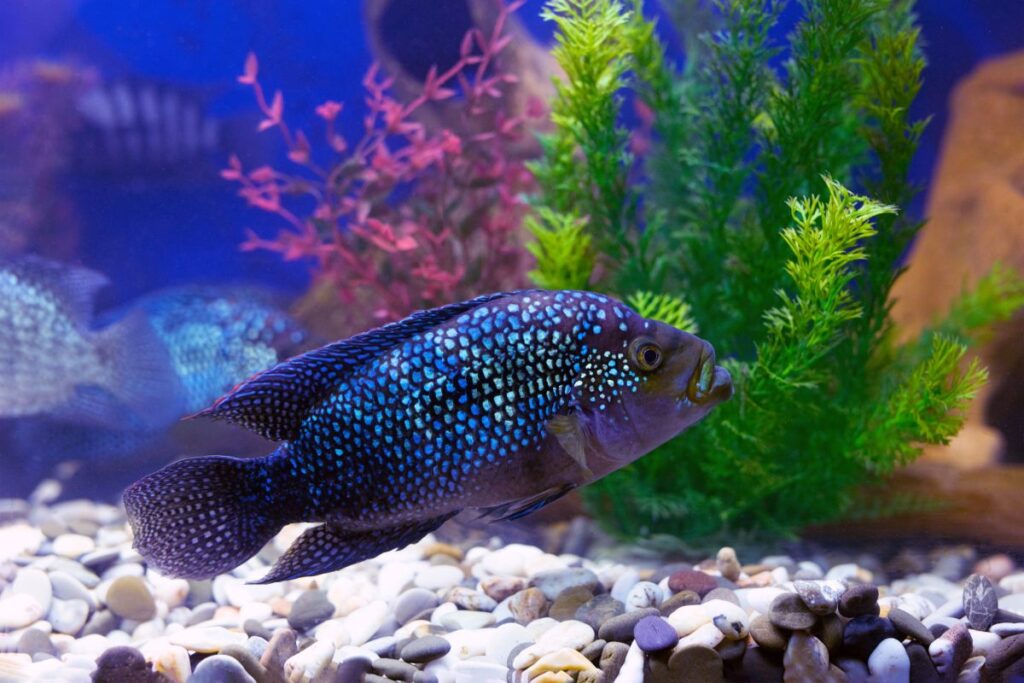
Personally, I have found that providing plenty of hiding spots and territories is crucial for keeping Jack Dempsey cichlids happy and healthy.
I like to use a combination of rocks, driftwood, and caves to create a natural-looking environment that provides plenty of hiding spots and territories for my fish.
With the right tank setup, you can enjoy the beauty and personality of these amazing fish for years to come.
Water Quality
Water Temperature
I find that maintaining a stable water temperature is crucial for the health of my Jack Dempsey cichlids. They prefer a water temperature between 75-80 degrees Fahrenheit.
Any fluctuations in temperature can cause stress and weaken their immune system, making them more susceptible to diseases.
Water pH
The ideal pH range for Jack Dempsey cichlids is between 7.0-8.0.
It’s important to monitor the pH levels regularly, as fluctuations can cause stress and harm to the fish. I use a pH testing kit to ensure that the pH levels remain within the acceptable range.
Water Hardness
Jack Dempsey cichlids prefer slightly hard water with a range of 10-20 dGH. Soft water can cause stress and weaken their immune system.
I add crushed coral or limestone to the aquarium to increase the water hardness and maintain a stable environment.
Water Changes
Regular water changes are essential for maintaining good water quality. I recommend changing 20-30% of the water every week to remove any accumulated waste and debris.
This helps to keep the water parameters stable and prevent the buildup of harmful toxins.
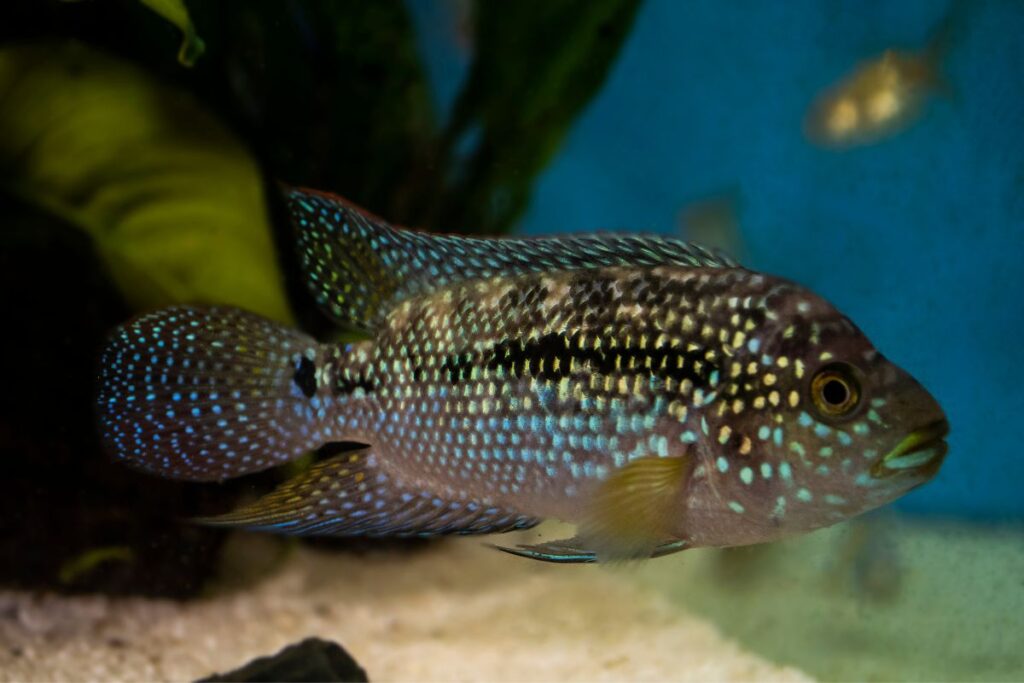
Overall, maintaining good water quality is crucial for the health and well-being of Jack Dempsey cichlids.
By monitoring the water temperature, pH levels, water hardness, and performing regular water changes, you can create a stable and healthy environment for your fish to thrive.
Tank Maintenance
Keeping a clean and healthy environment for your Jack Dempsey cichlid is crucial for their well-being. I like to do a 25% water change every week to maintain water quality.
While doing so, I also vacuum the gravel to remove any uneaten food, waste, or debris that may have accumulated on the bottom of the tank.
It’s important to monitor the water temperature and pH levels regularly. Jack Dempsey cichlids prefer a temperature between 75-80°F and a pH level between 7.0-8.0.
I use a thermometer and a water testing kit to ensure that the water conditions are optimal for my fish.
Another aspect of tank maintenance is cleaning the filter.
I clean my filter once a month to prevent any buildup of debris that could affect the water quality.
I also replace the filter media every three months to ensure that the filter is working efficiently.
Finally, I like to decorate my tank with live plants and driftwood. Not only do they provide hiding places for my fish, but they also help to maintain water quality by absorbing nitrates and other toxins.
However, it’s important to trim the plants regularly and remove any dead or decaying leaves to prevent them from affecting the water quality.
Tank Mates
Compatible Fish Species
I have found that Jack Dempsey cichlids can be kept with other fish species that are similar in size and temperament. Some compatible fish species include:
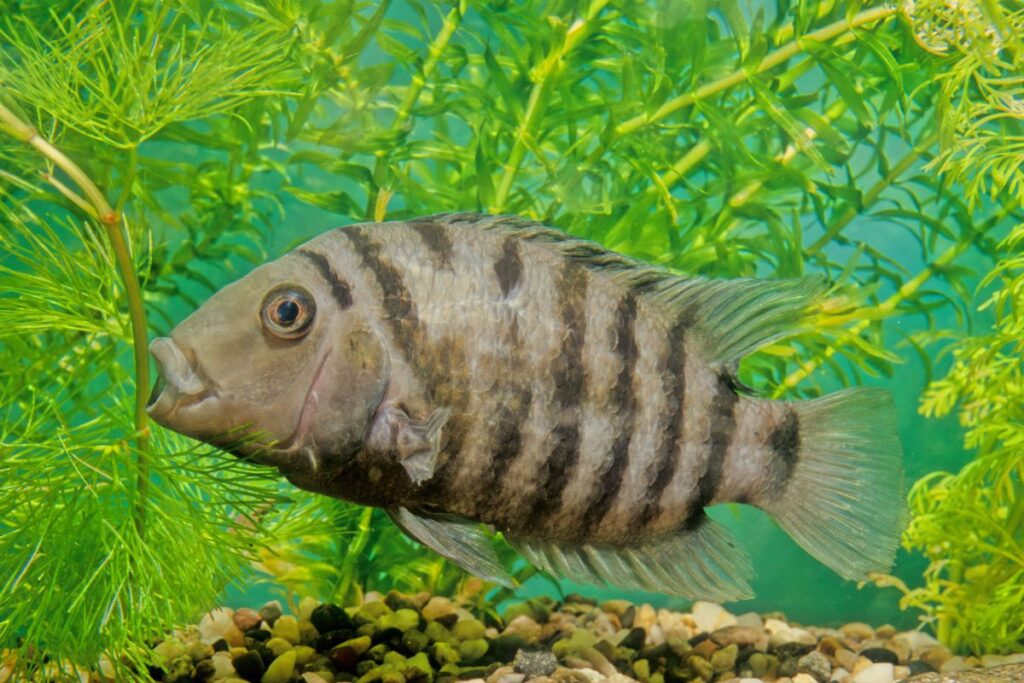
- Firemouth Cichlids
- Convict Cichlids
- Green Terror Cichlids
- Red Devil Cichlids
- Silver Dollars
- Tinfoil Barbs
It is important to note that even though these fish species are compatible, you should still monitor their behavior closely to ensure they are getting along.
Incompatible Fish Species
On the other hand, there are some fish species that should not be kept with Jack Dempsey cichlids. These fish species are either too aggressive or too small and may become prey. Some incompatible fish species include:
- Angelfish
- Neon Tetras
- Guppies
- Shrimp
- Snails
It is important to research any fish species that you are considering adding to your tank to ensure they are compatible with Jack Dempsey cichlids.
How many Jack Dempseys can live together?
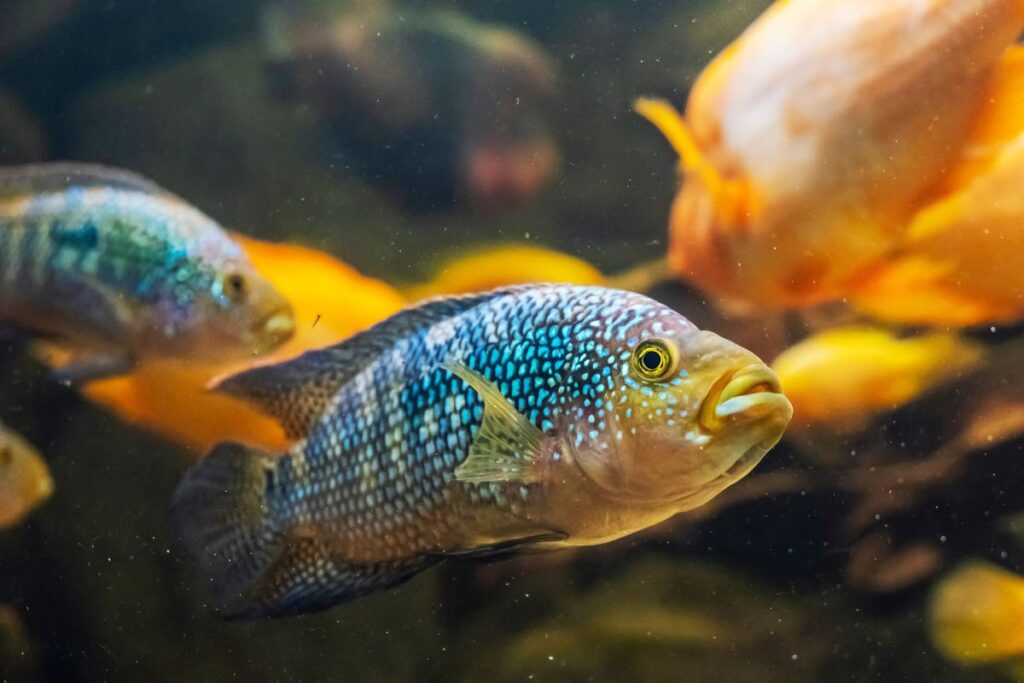
When it comes to keeping multiple Jack Dempsey cichlids together, it is important to remember that they can be territorial and aggressive towards each other.
As a general rule, you should keep one male with multiple females to avoid aggression. If you do decide to keep multiple males together, it is recommended to have a larger tank with plenty of hiding spots to reduce aggression.
Personally, I have found success keeping one male and two females together in a 75-gallon tank. They have plenty of room to swim and hide, and I have not experienced any aggression between them.
Diet
Feeding your Jack Dempsey cichlid the right diet is crucial to their health and well-being. In this section, I will cover what to feed your cichlid, how often to feed them, and some tips to keep in mind.
What To Feed
Jack Dempsey cichlids are omnivores, which means they eat both plants and animals. In the wild, they feed on insects, crustaceans, and small fish. You can replicate their natural diet by feeding them a variety of foods.
- High-quality cichlid pellets
- Frozen or live foods such as brine shrimp, bloodworms, and krill
- Fresh vegetables such as spinach, peas, and zucchini
- Fruits such as melon, mango, and papaya (in moderation)
It’s important to vary their diet to ensure they get all the necessary nutrients. Avoid overfeeding and feeding them too much protein, as this can lead to health problems.
Frequency
I feed my Jack Dempsey cichlid twice a day, once in the morning and once in the evening. It’s important not to overfeed them, as this can lead to obesity and health problems.
A good rule of thumb is to feed them only what they can eat in 2-3 minutes.
Tips
Here are some tips to keep in mind when feeding your Jack Dempsey cichlid:
- Remove any uneaten food after 5 minutes to prevent it from polluting the water
- Feed them a varied diet to ensure they get all the necessary nutrients
- Don’t overfeed them, as this can lead to obesity and health problems
- Consider using a feeding ring to prevent the food from spreading throughout the tank
By following these tips, you can ensure your Jack Dempsey cichlid stays healthy and happy.
When I first got my Jack Dempsey cichlid, I made the mistake of overfeeding him.
I thought I was doing him a favor by giving him lots of food, but I quickly realized my mistake when he started to become lethargic and his colors started to fade.
After adjusting his diet and feeding him less, he perked back up and his colors became more vibrant. It’s important to remember that less is often more when it comes to feeding your cichlid.
Common Diseases
Diseases
I’ve been keeping Jack Dempsey cichlids for years, and I’ve seen my fair share of diseases. Some of the most common ailments that can affect these fish include Ich, fin rot, and dropsy.
Ich is caused by a parasite that attaches itself to the fish’s body and fins, while fin rot is caused by bacteria that eat away at the fins.
Dropsy is a condition that causes the fish to become bloated and swollen, and it’s typically caused by a bacterial infection.
Symptoms
If you notice any of the following symptoms in your Jack Dempsey cichlid, it may be a sign that they are suffering from a disease:
white spots on their body or fins, frayed or discolored fins, lethargy or lack of appetite, bloating, or difficulty swimming.
If you notice any of these symptoms, it’s important to act quickly to prevent the disease from spreading.
Treatment
Treating diseases in Jack Dempsey cichlids can be tricky, but there are a few things you can do to help your fish recover.
For Ich, you can add medication to the water to kill the parasites. For fin rot, you’ll need to remove any infected fins and treat the water with antibiotics.
Dropsy is more difficult to treat, but you can try adding aquarium salt to the water to help reduce swelling.
Prevention
The best way to prevent diseases in Jack Dempsey cichlids is to maintain a clean and healthy environment for your fish.
This means regularly cleaning the tank, monitoring the water quality, and providing a balanced diet. It’s also important to quarantine any new fish before adding them to the tank to prevent the spread of disease.
Overall, taking care of Jack Dempsey cichlids can be a rewarding experience, but it’s important to be aware of the potential diseases that can affect these fish.
By staying vigilant and taking action when necessary, you can help ensure that your fish stay healthy and happy for years to come.
Signs of a Healthy Jack Dempsey
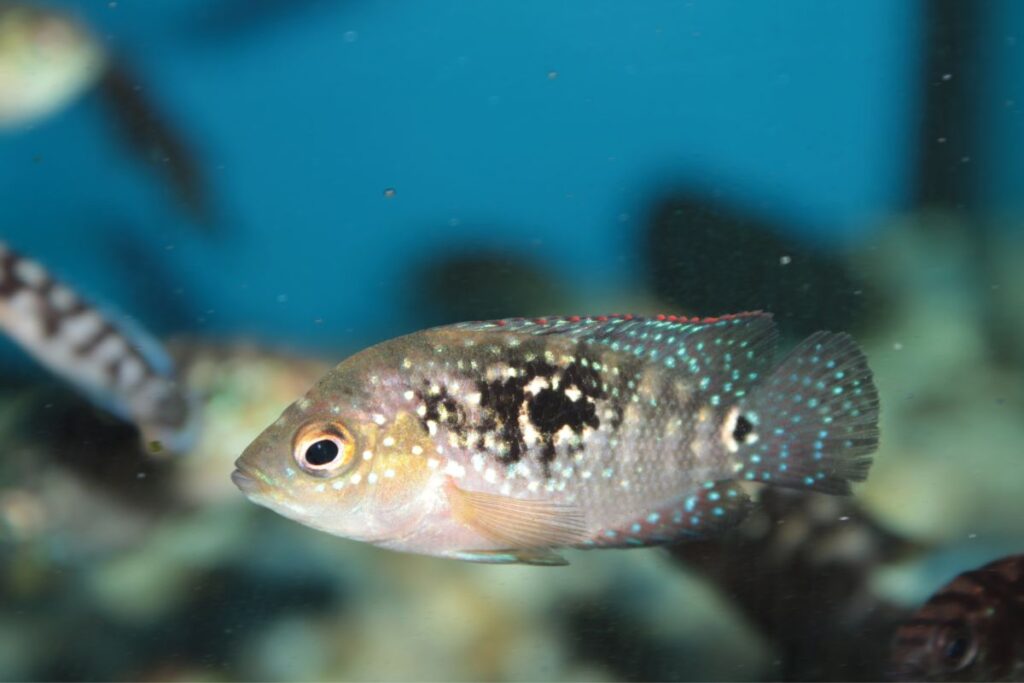
I have been keeping Jack Dempsey cichlids for several years now, and I have learned a lot about their care. One of the most important things I have learned is how to tell when a Jack Dempsey is healthy. Here are some signs to look for:
- Active and Alert: A healthy Jack Dempsey is always active and alert. They should be swimming around the tank, exploring their environment, and interacting with other fish. If your Jack Dempsey is lethargic or spends most of its time hiding, it could be a sign of illness.
- Bright Colors: Jack Dempsey cichlids are known for their beautiful colors, and a healthy fish will have bright and vibrant hues. The colors should be consistent and evenly distributed throughout the body. Faded or dull colors could be a sign of stress or illness.
- Clear Eyes: The eyes of a healthy Jack Dempsey should be clear and bright. Cloudy or sunken eyes could be a sign of an infection or other health issue.
- Healthy Fins: The fins of a healthy Jack Dempsey should be intact and free from any signs of damage or disease. Look for any tears, fraying, or discoloration, as these could be signs of fin rot or other health problems.
- Good Appetite: A healthy Jack Dempsey should have a good appetite and be eager to eat. If your fish is not interested in food or is not eating as much as usual, it could be a sign of illness.
By keeping an eye out for these signs, you can ensure that your Jack Dempsey is healthy and happy.
Remember, prevention is key when it comes to fish health, so always maintain good water quality, provide a balanced diet, and monitor your fish for any signs of illness.
Signs Your Jack Dempsey Is Sick
As a Jack Dempsey cichlid owner, it is important to be able to recognize the signs of illness in your fish. Here are some of the most common indicators that your Jack Dempsey may be sick:
- Loss of appetite: If your fish is not eating or showing interest in food, it may be a sign of illness.
- Abnormal swimming behavior: If your fish is swimming erratically, struggling to stay upright, or gasping for air at the surface, it may be a sign of illness.
- Physical abnormalities: Look for any unusual lumps, bumps, or discoloration on your fish’s body. These can be signs of disease or infection.
- Changes in waste output: If your fish’s waste output has changed significantly, it may be a sign of illness. This can include constipation, diarrhea, or abnormal coloration.
It is important to note that some of these symptoms can also be caused by poor water quality or other environmental factors.
However, if you notice any of these signs in your Jack Dempsey, it is best to take action immediately to ensure the health and well-being of your fish.
Personally, I once noticed that my Jack Dempsey had stopped eating and was swimming lethargically at the bottom of the tank. I immediately tested the water parameters and found that the ammonia levels were dangerously high.
After performing a water change and adding some beneficial bacteria, my fish made a full recovery within a few days. It is always better to be safe than sorry, so don’t hesitate to take action if you suspect that your fish may be sick.
Breeding
Breeding Jack Dempsey cichlids can be a rewarding experience. However, it requires careful planning and preparation. In this section, I will cover the breeding setup, how to breed, and care for the fry.
Breeding Setup
Before breeding, it is important to set up the breeding tank. The breeding tank should be at least 50 gallons and have a pH range of 6.5-7.5.
The temperature should be kept between 78-82°F. The tank should have a substrate of fine sand or small gravel and plenty of hiding places such as rocks, caves, and plants.
How To Breed
To breed Jack Dempsey cichlids, it is important to have a compatible pair. The male will display more vibrant colors and have a longer anal fin than the female.
Once you have a compatible pair, it is important to condition them with a high-quality diet of live or frozen foods.
The male will begin to court the female by displaying his fins and colors.
The female will lay eggs on a flat surface, such as a rock or slate, and the male will fertilize them. The female will then fan the eggs with her fins to provide oxygen and prevent fungus growth.
Care
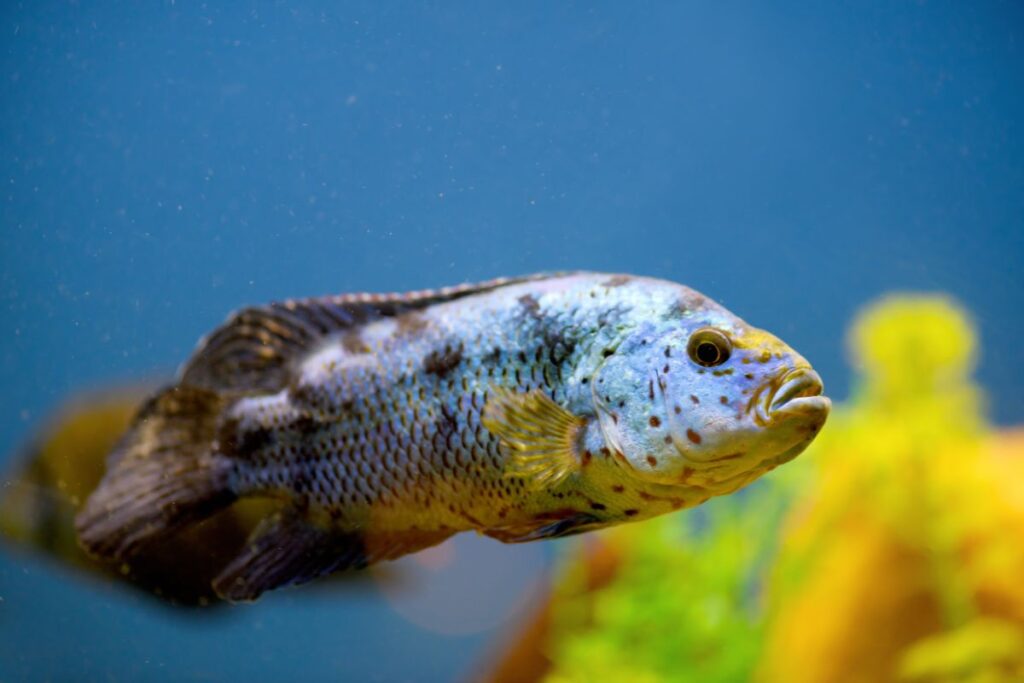
After the eggs have been fertilized, it is important to remove the parents from the breeding tank to prevent them from eating the eggs or fry.
The eggs will hatch in about 2-3 days, and the fry will become free-swimming after 5-7 days. The fry should be fed small amounts of live or frozen foods several times a day.
It is important to keep the water clean by performing frequent water changes and removing any uneaten food or debris. As the fry grow, they can be moved to a larger tank with a similar setup as the breeding tank.
Personal Anecdote: When I first attempted to breed Jack Dempsey cichlids, I made the mistake of not conditioning them with a high-quality diet. As a result, the eggs did not hatch, and I was left disappointed. However, after doing more research and providing a proper diet, I was able to successfully breed them.
Product recommendations for Jack Dempsey:
- Hikari Cichlid Gold – These pellets are specially formulated for cichlid fish like Jack Dempsey, and will provide them with the essential nutrients they need.
- Omega One Super Color Flakes – These flakes are a great option for feeding your Jack Dempsey, as they are high in protein and other important nutrients.
- API Stress Coat Water Conditioner – This water conditioner will help to reduce stress in your aquarium, which can be especially important for sensitive fish like Jack Dempsey.
- Seachem Cichlid Lake Salt – This salt is specifically designed to recreate the natural environment of cichlid fish like Jack Dempsey, and can help to promote their health and well-being.
- Fluval FX6 High Performance Canister Filter – This powerful filter is great for larger aquariums and can help to keep your water clean and clear, which is important for the health of your Jack Dempsey.
- Eheim Jager Aquarium Thermostat Heater – A heater is essential for maintaining a consistent water temperature in your aquarium, which is important for the health of your Jack Dempsey.
- API Master Test Kit – This test kit is a great way to monitor the levels of ammonia, nitrite, and nitrate in your aquarium, which can help you keep your Jack Dempsey healthy.
- CaribSea African Cichlid Mix: – This substrate is specifically designed for cichlid fish like Jack Dempsey, and can help to recreate their natural environment in your aquarium.
- Hydor Koralia Nano Aquarium Circulation Pump – A circulation pump can help to keep the water in your aquarium moving, which can be important for the health of your Jack Dempsey.
- Penn Plax Cascade Canister Aquarium Filter – This high-quality canister filter is another great option for keeping your water clean and clear, which is important for the health of your Jack Dempsey.
Conclusion
Overall, caring for Jack Dempsey cichlids can be a rewarding and enjoyable experience. With the right setup, diet, and maintenance, these fish can thrive and bring joy to any aquarium.
Personally, I have found that Jack Dempseys are some of the most fascinating fish to watch. Their unique personalities and behaviors make them stand out in any tank. However, it is important to remember that they require a bit more effort and attention than some other fish species.
By following the tips and guidelines outlined in this article, you can ensure that your Jack Dempsey cichlids live happy and healthy lives. Remember to provide them with plenty of space, a balanced diet, and regular water changes. And don’t forget to enjoy the beauty and wonder of these amazing fish!
FAQs
As a seasoned Jack Dempsey cichlid owner, I often get asked a lot of questions about how to properly care for them. Here are some of the most frequently asked questions:
Q: What kind of tank setup do Jack Dempsey cichlids need?
A: Jack Dempsey cichlids are large fish and require a tank that is at least 55 gallons. They prefer a tank with plenty of hiding places, such as caves, rocks, and plants. It’s important to provide a substrate that is suitable for their digging behavior, such as sand or fine gravel. Keep the water temperature between 78-82°F and the pH between 7.0-8.0.
Q: What do Jack Dempsey cichlids eat?
A: Jack Dempsey cichlids are omnivores and will eat a variety of foods, including pellets, flakes, frozen foods, and live foods. It’s important to provide a balanced diet and not overfeed them. I personally feed my Jack Dempsey cichlids a mix of pellets, frozen bloodworms, and brine shrimp.
Q: Can Jack Dempsey cichlids be kept with other fish?
A: Jack Dempsey cichlids can be aggressive towards other fish, especially during breeding season. It’s best to keep them with other large and aggressive fish, such as other cichlids. I’ve had success keeping my Jack Dempsey cichlids with other large cichlids, such as Oscars and Green Terrors.
Q: How often should I do water changes?
A: It’s important to do regular water changes to maintain good water quality. I recommend doing a 25% water change every week. This will help keep the water parameters stable and prevent any health issues from arising.
Q: What are some common health issues with Jack Dempsey cichlids?
A: Jack Dempsey cichlids are prone to several health issues, including ich, fin rot, and hole-in-the-head disease. It’s important to monitor their behavior and appearance for any signs of illness. I always keep a close eye on my Jack Dempsey cichlids and perform regular water changes to prevent any health issues from occurring.
Overall, Jack Dempsey cichlids can be a rewarding and fascinating fish to keep. With proper care and attention, they can live a long and healthy life. As always, if you have any concerns or questions about your Jack Dempsey cichlid, don’t hesitate to consult with a veterinarian or experienced fish keeper.
Reference: Wikipedia.
